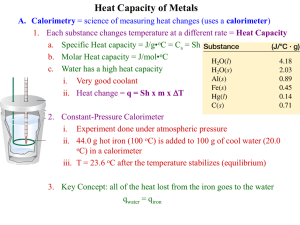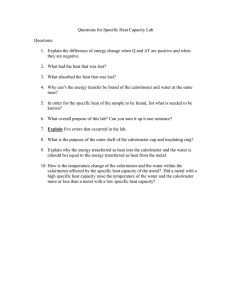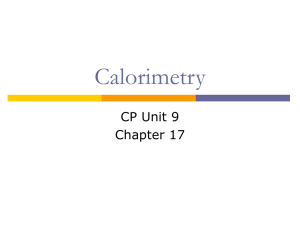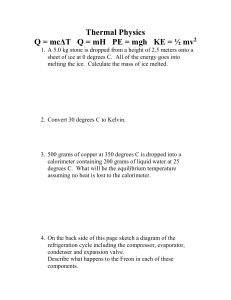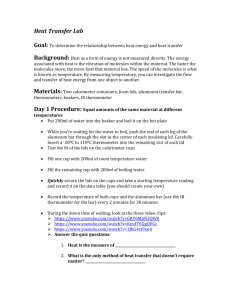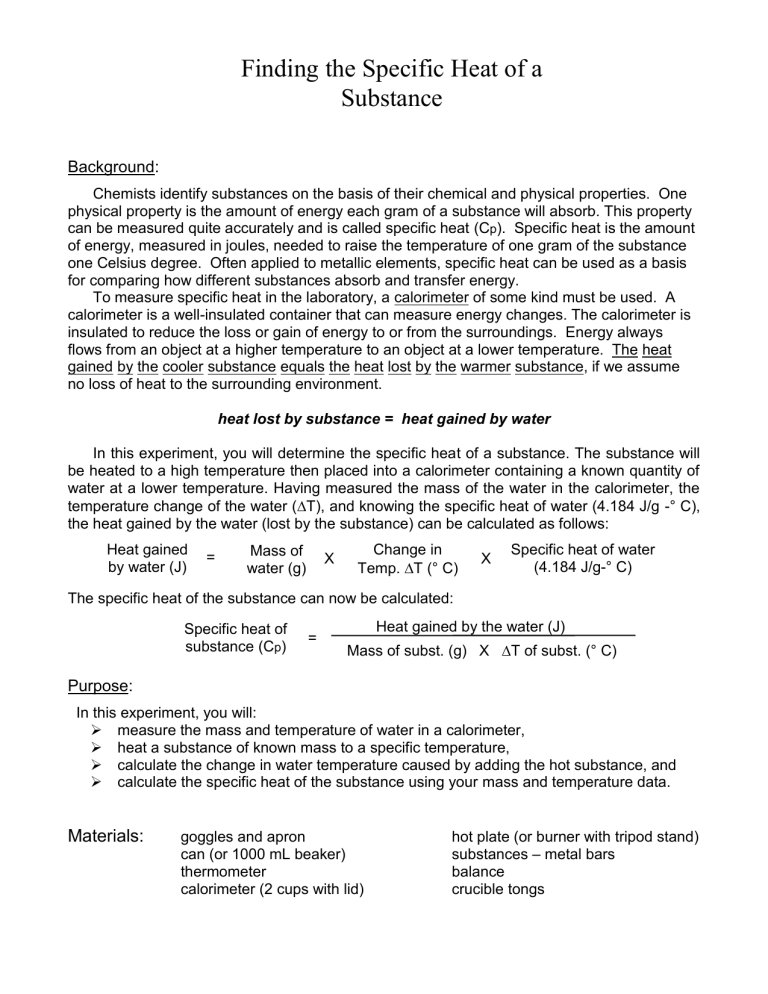
Finding the Specific Heat of a Substance Background: Chemists identify substances on the basis of their chemical and physical properties. One physical property is the amount of energy each gram of a substance will absorb. This property can be measured quite accurately and is called specific heat (Cp). Specific heat is the amount of energy, measured in joules, needed to raise the temperature of one gram of the substance one Celsius degree. Often applied to metallic elements, specific heat can be used as a basis for comparing how different substances absorb and transfer energy. To measure specific heat in the laboratory, a calorimeter of some kind must be used. A calorimeter is a well-insulated container that can measure energy changes. The calorimeter is insulated to reduce the loss or gain of energy to or from the surroundings. Energy always flows from an object at a higher temperature to an object at a lower temperature. The heat gained by the cooler substance equals the heat lost by the warmer substance, if we assume no loss of heat to the surrounding environment. heat lost by substance = heat gained by water In this experiment, you will determine the specific heat of a substance. The substance will be heated to a high temperature then placed into a calorimeter containing a known quantity of water at a lower temperature. Having measured the mass of the water in the calorimeter, the temperature change of the water (T), and knowing the specific heat of water (4.184 J/g -° C), the heat gained by the water (lost by the substance) can be calculated as follows: Heat gained by water (J) = Mass of water (g) X Change in Temp. T (° C) X Specific heat of water (4.184 J/g-° C) The specific heat of the substance can now be calculated: Specific heat of substance (Cp) = Heat gained by the water (J) Mass of subst. (g) X T of subst. (° C) Purpose: In this experiment, you will: measure the mass and temperature of water in a calorimeter, heat a substance of known mass to a specific temperature, calculate the change in water temperature caused by adding the hot substance, and calculate the specific heat of the substance using your mass and temperature data. Materials: goggles and apron can (or 1000 mL beaker) thermometer calorimeter (2 cups with lid) hot plate (or burner with tripod stand) substances – metal bars balance crucible tongs Procedure: 1. If the hot plate you are sharing is not on, turn it on #8. The can should only have about 2” – 2.5” of water in it. More water than that and you’ll never get it to boil. If the water level ever drops below 1”, tell the instructor so he/she can add more water to it. You want this water in the can boiling as soon as possible. 2. Obtain a sample of a metal or other substance supplied by your instructor. Record the type of substance in the data table. Find the mass of the substance and record its mass in the data table. 2. With the tongs, carefully place the substance into the can of boiling water. Do not drop it into the beaker because you do not want to break the beaker or thermometer. If another team’s substance is in the can, remember which substance is yours. You cannot switch pieces because it may be a different substance, and will certainly have a different mass. The thermometer that is in the can or beaker is measuring the temperature of the boiling water. After your substance has been sitting in the water about 3 minutes, the initial temperature of the substance will be the same as the temperature of the boiling water. CAUTION: Do not tip the can over and do not burn yourself. 3. While one person in your team is monitoring the substance in the boiling water, another member of your team should find the exact mass of the styrofoam cups (and lid if one is available), and record it in your data table (use two cups, one inside the other, for better insulation). Fill the cup no more than one-fourth full of tap water (an inch or two is all you need) and then determine the mass of the cups and water. Subtract to find the mass of the water. 4. Place the thermometer in the calorimeter (the styrofoam cups) and wait till the red liquid has completely stopped moving. Measure the initial temperature of the water. Remember the bulb of the thermometer must be in the water when you measure the temperature. You cannot lift the thermometer out of the water to read it!! 5. Add the sample substance to the water in the calorimeter and quickly place the lid on (if one is available) so the thermometer sticks out the hole in the lid. 6. Occasionally swirl the calorimeter so the water maintains an even temperature. Do this slowly and gently so you do not break the thermometer. 7. Heat from the hot substance is moving into the water. This will continue until both the water and the substance are the same temperature. When the thermometer has stopped rising, record the final temperature of the system (the water and the substance are the same temperature). Remember the bulb of the thermometer must be in the water when you measure the temperature. You cannot lift the thermometer out of the water to read it!! 8. Remove the thermometer and the substance. Discard the water in the calorimeter. Repeat the procedure with a second sample. Chemistry-1 Lab: Specific Heat Page 2 Name ___________________________________ Lab Partner ______________________________ Lab Partner ______________________________ Lab Partner ______________________________ Date of Lab ______________ Per. _____ Specific Heat Lab Data: (Remember to write correct units!!) 1st Type of Metal: _______________ 2nd Type of Metal: ______________ Mass of Cups & Water _________ Mass of Cups & Water _________ Mass of Cups _________ Mass of Cups _________ Mass of Water (in calorimeter) _________ Initial Temp. of Water _________ *Final Temp of Water _________ Mass of metal _________ Initial Temp. Hot Metal _________ *Final Temp. Metal _________ (in calorimeter) Mass of Water (in calorimeter) _________ Use for #1 below Use for #2 below * = same temp. Initial Temp. of Water _________ *Final Temp of Water _________ Mass of metal _________ Initial Temp. Hot Metal _________ *Final Temp. Metal _________ (in calorimeter) Results: 1. Calculate the heat gained by the water (lost by the substance) in the calorimeter using the equation in the Introduction. Remember to write the units!! Q for water using 1st Metal Qwater = mwater x (Tf - Ti)water x Cp water Q for water using 2nd Metal Qwater = mwater x (Tf - Ti)water x Cp water 2. Calculate the specific heat of the substance using the answer from number 1 and the equation in the Introduction. Now, Cp is your unknown since you’re using Q from #1. Cp of 1st Metal Qsubst = msubst x (Ti - Tf)subst x Cp subst Qsubst Cp = msubst x (Ti - Tf) subst Cp = ____________ J/g -° C Cp for 2nd Metal Qsubst = msubst x (Ti - Tf)subst x Cp subst Qsubst Cp Q = msubst x (Ti - Tf) subst Cp = ____________ J/g -° C 3 sf 3 sf 3. Look up the specific heat of your substance samples and find your percent error. Substance #1: Experimental Cp ___________ Substance #2: Experimental Cp ____________ Substance #1: Literature Cp Substance #2: Literature Cp ____________ Percent Yield:______________________ ____________ Percent Yield:____________________________ Sample Data Specific Heat Lab Data: (Remember to write correct units!!) 2nd Type of Substance: ______________ Aluminum 1st Type of Substance: _______________ Brass Mass of Cups & Water _________ 142.99 g Mass of Cups & Water _________ 170.54 g Mass of Cups _________ 6.76 g Mass of Cups _________ 6.83 g Mass of Water _________ 136.23 g Mass of Water 163.71 g _________ Initial Temp. of Water _________ 24.0 °C Initial Temp. of Water _________ 24.0 °C *Final Temp of Water _________ 27.0 °C *Final Temp of Water 26.0 °C _________ Mass of substance 68.11 g _________ Mass of substance 21.95 g _________ 100 °C Initial Temp. Substance _________ Use for #1 below Use for #2 below Initial Temp. Substance _________ 100 °C 26.0 °C *Final Temp. Substance _________ *Final Temp. Substance _________ 27.0 °C * = same temp. * = same temp. Results: 1. Calculate the heat gained by the water (lost by the substance) in the calorimeter using the equation in the Introduction. Remember to write the units!! Q for water using 1st substance Qwater = mwater x (Tf - Ti)water x Cp water Q for water using 2nd substance Qwater = mwater x (Tf - Ti)water x Cp water Q = 136.23 g x (27.0 – 24.0) °C x 4.184 J/g°C Q = 136.23 g x 3 °C x 4.184 J/g°C Q = 1,709.959 J Q = 163.71 g x (26.0 – 24.0) °C x 4.184 J/g°C Q = 163.71 g x 2 °C x 4.184 J/g°C Q = 1,369.925 J 2. Calculate the specific heat of the substance using the answer from number 1 and the equation in the Introduction. Now, Cp is your unknown since you’re using Q from #1. Cp of 1st substance Qsubst = msubst x (Ti - Tf)subst x Cp subst Qsubst Cp = msubst x (Ti - Tf) subst Cp = Cp for 2nd substance Qsubst = msubst x (Ti - Tf)subst x Cp subst Qsubst Cp Q = msubst x (Ti - Tf) subst 1,709.959 J Cp 68.11 g x 73 °C = 1,369.925 J 21.95 g x 74 °C 0.843 Cp = ____________ J/g -° C 0.344 Cp = ____________ J/g -° C 3 sf 3 sf 3. Look up the specific heat of your substance samples and find your percent error. J/g°C Brass (Iron): Experimental Cp 0.344 ___________ Iron: Literature Cp Chemistry-1 ____________ 0.37 J/g°C 0.843 J/g°C Aluminum: Experimental Cp ____________ Aluminum: Literature Cp Lab: Specific Heat 0.89 J/g°C ____________ Page 4
